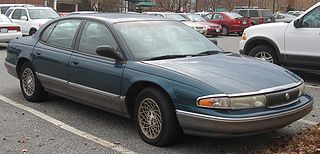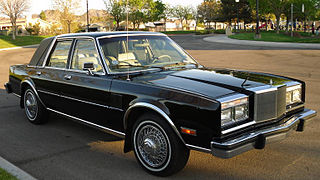
Plymouth was a brand of automobiles produced by Chrysler Corporation and its successor DaimlerChrysler. The brand was launched in 1928 to compete in what was then described as the "low-priced" market segment that was dominated by Chevrolet and Ford. It became a high-volume seller for the automaker until the late 1990s. Plymouth cars were marketed primarily in the United States. The brand was withdrawn from the marketplace in 2001. The Plymouth models that were produced up to then were either discontinued or rebranded as Chrysler or Dodge.

The Plymouth Reliant and Dodge Aries are mid size cars introduced for model year 1981 as the first "K-cars" manufactured and marketed by the Chrysler Corporation. The Reliant and Aries were the smallest cars to have the traditional 6 passenger 2 bench seat with column shifter seating arrangement favored by customers in the United States, similar to larger rear-wheel drive cars such as the Dodge Dart and other front-wheel drive cars such as the Chevrolet Celebrity. The Reliant was powered by a then-new 2.2 L I4 SOHC engine, with a Mitsubishi "Silent Shaft" 2.6 L as an option. The Reliant was available as a 2-door coupe, 4-door sedan, or as a 4-door station wagon, in three different trim lines: base, Custom and SE. Station wagons came only in Custom or SE trim.

The Chrysler Cirrus is a mid-sized 4-door notchback sedan introduced by Chrysler motors for the 1995 model year. Built on the Chrysler JA platform, the 4-door notchback sedan joined Chrysler's roster of "Cloud Car" models drawing their names from meteorological terms, including the mid-priced Dodge Stratus it was based on introduced at the same time, and the low-priced Plymouth Breeze variant a year later.

The Chrysler New Yorker is an automobile model that was produced by Chrysler from 1940 until 1996, serving for several decades as either the brand's flagship model or as a junior sedan to the Chrysler Imperial, the latter during the years in which the Imperial name was used within the Chrysler lineup rather than as a standalone brand.

The Chrysler Fifth Avenue was a trim level/option package or model name used by Chrysler for its larger sedans from 1979 to 1993. The Fifth Avenue name was no longer used after 1993 when Chrysler introduced its new LH-platform New Yorker and similar LHS. The title "Fifth Avenue" references a street in New York City which contains many upscale shops and cultural attractions. The Chrysler Building is two blocks east of Fifth Avenue.

The K-car platform was a key automotive design platform introduced by Chrysler Corporation for the 1981 model year, featuring a transverse engine, front-wheel drive, independent front and semi-independent rear suspension configuration—a stark departure from the company's previous reliance on solid axle, rear-drive unibody configurations during the 1970s. Derived from Chrysler's L-cars, the Plymouth Horizon and Dodge Omni, the platform was developed just as the company faltered in the market, at first underpinning a modest range of compact/mid-size sedans and wagons—and eventually underpinning nearly fifty different models, including all-wheel drive variants—and playing a vital role in the company's subsequent resurgence.

The Dodge Omni is a subcompact car that was produced by Chrysler Corporation from the 1978 to 1990 model years. The first Chrysler model line produced with front-wheel drive, the Omni and Horizon were also the first front-wheel drive economy cars assembled in the United States. Marketed for eleven years with very few changes, around 2,500,000 Omnis and Horizons were built with the Plymouth badged versions more popular than the Dodge branded models.

The Chrysler LeBaron, also known as the Imperial LeBaron, is a line of automobiles built by Chrysler from 1931 to 1941 and from 1955 to 1995. The model was introduced in 1931, with a body manufactured by LeBaron, and competed with other luxury cars of the era such as Lincoln and Packard. After purchasing LeBaron with its parent Briggs Manufacturing Company, Chrysler introduced the luxury make Imperial in 1955, and sold automobiles under the name Imperial LeBaron until 1975. Chrysler discontinued the Imperial brand in 1975, and reintroduced the Chrysler LeBaron in 1977 to what was then Chrysler's lowest priced model.

The Dodge Colt is a subcompact car that was manufactured by Mitsubishi Motors and marketed by Dodge for model years 1971 to 1994 as captive imports. Rebadged variants include the Plymouth Champ and Plymouth Colt, both were marketed by Plymouth.

Plymouth Voyager is a nameplate for a range of vans that were marketed by the Plymouth division of Chrysler. From 1974 until 1983, the Voyager was a full-size van, sold as the counterpart of Dodge Sportsman. Starting with the 1984 model year, the Voyager was marketed as one of the new Chrysler minivan, along with the Dodge Caravan. As a minivan, there were three generations of the Voyager from 1984 until 2000. Following the closure of the Plymouth division in 2000, the Voyager was marketed under the Chrysler brand as a lower-trim version of the Chrysler Town & Country through 2003.

The Dodge Stratus is a mid-size car that was introduced by Dodge in December 1994 and was based on the 4-door sedan Chrysler JA platform. The Stratus, Plymouth Breeze, and Chrysler Cirrus were all on Car and Driver magazine's Ten Best list for 1996 and 1997. It received critical acclaim at launch, but ratings fell over time. An updated version of the Stratus was introduced for 2001, with the Cirrus being renamed as the Chrysler Sebring, and a coupé model was also added to the range. Production ended in early 2006 at the Sterling Heights Assembly Plant after building 1,308,123 Stratus and Sebrings since 2000.

The Chrysler M Platform was an intermediate-sized automobile platform used by Chrysler motors from 1977 to 1989. It was a successor to the F-body, as used on the Dodge Aspen/ Plymouth Volare. The M-body was also the successor to the short-lived R-body, as the Chrysler New Yorker and Plymouth Gran Fury moved to it following the R-body's demise in 1981. The M platform was the final production passenger car with a solid rear axle mounted on Hotchkiss-style, parallel semi-elliptical leaf springs sold in the U.S.

The Dodge Magnum is a nameplate used by several Dodge vehicles, at different times and on various markets. The name was first applied to a large Chrysler B platform-based 2-door coupe marketed from 1978 to 1979 sold in the United States and Canada. From the 2005 to the 2008 model years, the nameplate was revived for a Charger-based station wagon on the rear-wheel drive Chrysler LX platform, produced in Canada and sold on the American and Canadian market.

The Dodge Aspen, and the nearly-identical PlymouthVolaré, are compact cars that were produced from 1976 until 1980. The Volaré/Aspen model line offered a four-door sedan, a two-door coupe, and a four-door wagon.

The Dodge Diplomat is an American mid-size car that was produced by Dodge from 1977 to 1989. At launch, it shared a common design with the Chrysler LeBaron and for much of its later production run was the counterpart of the more upscale Chrysler Fifth Avenue and lower priced Plymouth Gran Fury. It was also sold in Mexico between 1981 and 1982 as the Dodge Dart, and in Colombia as the Dodge Coronet. The Diplomat was initially offered in a coupe and a sedan; in 1978, station wagons were added as replacements for the discontinued full-sized C-body wagons.

The Neon is a compact car that was built from in January 1994 until 2005 by the American Chrysler Corporation over two generations. It has a front-engine, front-wheel-drive layout and came in two-door and four-door sedan body styles. In the United States it was sold as either a Dodge or a Plymouth, while in Europe, Mexico, Canada, Japan, South Korea, Egypt, Australia, South Africa, and South America it was branded as a Chrysler, the Neon was offered in multiple versions and configurations over its production life, which lasted from the 1995 model year until 2005. The Neon nameplate was subsequently resurrected in 2016 for the Dodge Neon, a rebadged variant of Fiat Tipo sedan for the Mexican market.

The Plymouth Fury is a model of automobile that was produced by Plymouth from 1955 until 1989. It was introduced for the 1956 model year as a sub-series of the Plymouth Belvedere, becoming a separate series one level above the contemporary Belvedere for 1959. The Fury was a full-size car from 1959 until 1961, then a mid-size car from 1962 until 1964, again, a full-size car from 1965 through 1974, and again, a mid-size car from 1975 through 1978. From 1975 until 1977, the Fury was sold alongside the full-size Plymouth Gran Fury. In 1978, the B-body Fury was the largest Plymouth, and by 1979, there was no large Plymouth. This product gap was filled in 1980 with the R-body Gran Fury, followed by the M-body Fury in 1982. Production of the last V8, RWD Plymouth Fury ended at the Kenosha Main assembly plant in Kenosha, WI, on December 23, 1988. Unlike its sibling brand, Dodge, Plymouth would not live to see the resurgence of the large, V8/RWD sedan.

TorqueFlite is the trademarked name of Chrysler Corporation's automatic transmissions, starting with the three-speed unit introduced late in the 1956 model year as a successor to Chrysler's two-speed PowerFlite. In the 1990s, the TorqueFlite name was dropped in favor of alphanumeric designations, although the latest Chrysler eight-speed automatic transmission has revived the name.

The Plymouth Gran Fury is a full-sized automobile that was manufactured by Plymouth from 1975 to 1989. The nameplate would be used on successive downsizings, first in 1980, and again in 1982, through what would originally have been intermediate and compact classes in the early 1970s, all with conventional rear-wheel drive layouts. By the time Chrysler ended M-body production in December 1988, they were Chrysler's last remaining rear-wheel drive cars, with a V8 and carburetor, a configuration used since the mid-1950s. Plymouth did not have another rear-wheel drive car until the 1997 Prowler roadster.

The first-generation Chrysler minivans are a series of minivans produced and marketed by the Chrysler Corporation from the 1984 to the 1990 model years. Introduced as the first minivans from an American-brand manufacturer and popularizing the minivan as a vehicle, the Dodge Caravan and Plymouth Voyager were launched ahead of chief competitors Chevrolet Astro/GMC Safari and Ford Aerostar.






















